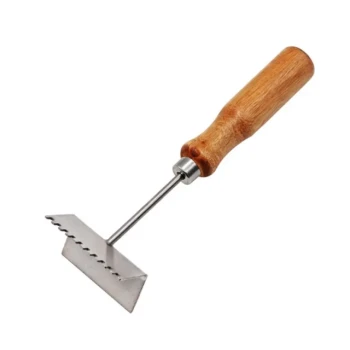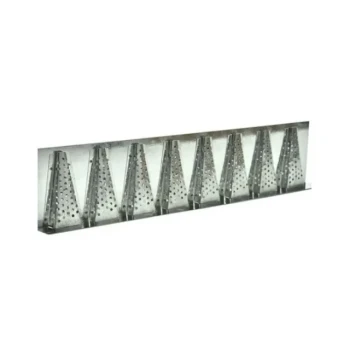Queen excluders are essential tools in beekeeping, designed to enhance hive management and ensure pure honey production. These selective barriers allow worker bees to pass through while preventing the queen and drones from entering the honey storage area. Our range includes wooden, plastic, and metal queen excluders, each crafted for durability and precise fit. Whether you're managing a small apiary or a large-scale operation, our queen excluders simplify inspections and help control colony behavior. Explore our collection to find the perfect solution for your beekeeping needs.
Toggle Categories
Get Instant Support
Choose your preferred way to connect with our team
-
Get Free Quote Fill out form for detailed pricing
-
Send Email Detailed inquiry support
-
WhatsApp Quick mobile chat
Response Time
Within 8 hours on working days, 24 hours on holidays
beekeeping queen excluder

Wooden Queen Bee Excluder for Beekeeping
Item Number : QE-1

Plastic Queen Bee Excluder for Bee Hive Wholesale
Item Number : QE-2

Metal Queen Bee Excluder for Beekeeping
Item Number : QE-4

Professional Dual Action Queen Excluder Scraper for Beekeeping
Item Number : QES-1

Lightweight Durable Plastic Queen Excluder Scraper for Beekeeping
Item Number : QES-3

Multi-Functional Sliding Hive Entrance for Beekeeping
Item Number : E-7

Multi-Functional Rotary Hive Entrance Disc for Beekeeping
Item Number : E-8

8-Cone Galvanized Steel Bee Robber Guard
Item Number : TAR-1
Why Choose Our Queen Excluders for Beekeeping?
Queen excluders are indispensable tools for beekeepers aiming to optimize hive management and honey production. Our selection of queen excluders includes options made from eco-friendly fir wood and bamboo, durable plastic, and robust metal, catering to various beekeeping needs and preferences.
Features and Benefits
-
Precision Design: Our queen excluders are crafted with gaps spaced between 4.1 and 4.4 millimeters, allowing worker bees to pass through while preventing the larger queen and drones from entering the honey supers. This ensures that your honey storage area remains free of brood, making honey extraction cleaner and more efficient.
-
Durability and Longevity: Whether you choose our wooden, plastic, or metal excluders, each product is designed for long-term use. The wooden excluders are made from sustainable materials, the plastic ones are lightweight yet sturdy, and the metal excluders offer unmatched durability.
-
Ease of Management: By confining the queen to the brood chamber, our excluders simplify hive inspections and make it easier to locate the queen. This not only saves time but also reduces stress on the colony.
-
Colony Control: Our queen excluders help manage the size and temperament of your bee colony. They are particularly useful in Africanized zones, where controlling colony defensiveness is crucial.
-
Pest Management: By preventing the queen from laying eggs in the honey frames, our excluders reduce the attraction of wax moths and help in managing varroa mite populations.
How Queen Excluders Work
Queen excluders function by exploiting the size difference between worker bees and the queen. The precisely spaced gaps in the excluder allow worker bees to move freely between the brood chamber and the honey supers while keeping the queen confined to the brood area. This ensures that the honey supers remain free of brood, containing only pure honey.
Applications
Our queen excluders are versatile tools used in various beekeeping activities, including:
-
Honey Harvesting: Ensure that your honey supers are free of brood, making honey extraction simpler and more efficient.
-
Propolis and Royal Jelly Production: By controlling the queen's movement, you can optimize the production of these valuable bee products.
-
Multi-Queen Colonies: Facilitate the management of colonies with multiple queens, enhancing your beekeeping operations.
Customizable Solutions
We understand that every beekeeper has unique needs. That's why we offer customizable queen excluders tailored to your specific requirements. Whether you need a particular size, material, or design, our team is here to help.
Call to Action
Ready to enhance your beekeeping experience? Explore our range of queen excluders and find the perfect fit for your hive. Have questions or need a custom solution? Contact us today to learn more about our products and services. Our expert team is here to assist you in optimizing your beekeeping operations for maximum efficiency and productivity.
FAQ
What Is The Principle Of A Beekeeping Queen Excluder?
What Are The Advantages Of Using A Beekeeping Queen Excluder?
What Are The Applications Of A Beekeeping Queen Excluder?
What Are The Main Types Of Beekeeping Queen Excluders?
How Does A Beekeeping Queen Excluder Simplify Hive Management?
REQUEST A QUOTE
Our professional team will reply to you within one business day. Please feel free to contact us!
Related Articles

The Calculus of the Swarm: How a Controlled Fracture Prevents a Catastrophic Split
A beehive's success creates its greatest risk: swarming. Learn how a nuc split works with bee biology to manage growth and prevent colony loss.

Beyond the Gate: The Queen Excluder as a Keystone of Apiary Efficiency
Choosing a queen excluder is a strategic decision balancing cost vs. durability, directly impacting harvest efficiency and long-term apiary profitability.

The Ten-Year Gate: Why Your Queen Excluder Defines Your Apiary's Economics
Explore the economic trade-offs between plastic and metal queen excluders. Learn why long-term durability is a critical investment for commercial apiaries.

Strategic Timing for Adding Foundation Frames: Aligning Beekeeping Practices with Colony Biology
Learn when to add foundation frames to beehives for optimal colony growth. Align with nectar flows, bee biology, and seasonal patterns.

Beyond Upfront Cost: Why Metal Queen Excluders Are an Investment in Apiary Efficiency
Discover why metal queen excluders, despite a higher cost, outperform plastic by ensuring bee space and long-term operational efficiency.

Beyond the Apiary: The Beekeeping Veil as a Tool for Focus
The beekeeping hat is a personal screen room for your head, an essential tool for focus in any outdoor activity plagued by insects.

Optimizing Beehive Entrance Discs: When Freedom Boosts Hive Performance
Learn how optimizing beehive entrance discs boosts hive performance by enhancing foraging, ventilation, and security with seasonal adjustments.

The Geometry of Order: Why the Queen Excluder is a Beekeeper's Most Strategic Tool
A queen excluder's material and fit are strategic choices impacting hive efficiency, honey purity, and long-term operational costs.

Galvanized vs. Stainless Steel Queen Excluders: A Data-Backed Guide to Long-Term Durability and Cost Efficiency
Compare galvanized vs. stainless steel queen excluders for durability, cost efficiency, and hive compatibility. Choose the best for your beekeeping needs.

Why Your Strongest Hives Swarm—And the Simple Swap That Prevents It
Frustrated by spring swarms cutting into your profits? Discover why hive congestion is the true cause and how a simple technique can boost colony strength and honey yield.

Beyond the Embosser: The Systems Thinking Behind Perfect Beeswax Foundation
A beeswax foundation machine is a system, not a single device. Understanding its components is key to scaling production from manual craft to commercial consistency.

The Second Skin: A Beekeeper's Guide to Glove Longevity and Apiary Health
Properly cleaning beekeeping gloves isn't just about hygiene; it's a discipline that preserves your investment and protects your apiary's health.

Mastering Beeswax Demolding: Thermal Control and Tactile Techniques for Flawless Sheets
Learn expert beeswax demolding techniques for flawless sheets—thermal control, tactile assessment, and mold optimization for beekeepers.

How Queen Excluders Optimize Hive Productivity: Benefits, Limitations & Advanced Techniques
Learn how queen excluders optimize hive productivity, their benefits, limitations, and advanced techniques for beekeepers.

Chaos and Order: The Strategic Value of Beeswax Foundation
Explore how beeswax foundation imposes a predictable order on bee colonies, reducing risk and boosting productivity for commercial apiaries.

The Tipping Point: Managing the Psychology of a Beehive to Prevent Swarming
Swarm prevention is not about stopping bees, but about managing the psychological triggers of congestion and resource perception within the hive.

The Art of Persuasion: Engineering the Perfect Conditions for Queen Rearing
Successful queen rearing is about engineering a colony's psychology to trigger its natural swarm impulse for superior, consistent results.

Tired of Sagging Comb? The Hidden Cost of "Cheap" Beekeeping Frames
Discover why unstable comb in your beehives is more than an inconvenience, leading to lost honey and stressed bees. Learn the real cost of frame choices.

Beyond the Bee Box: Why Your First Apiary Investment Determines Your Success
Discover the root cause of first-year hive failure. Learn why cheap starter kits often fail and how professional-grade equipment ensures apiary growth and profitability.
